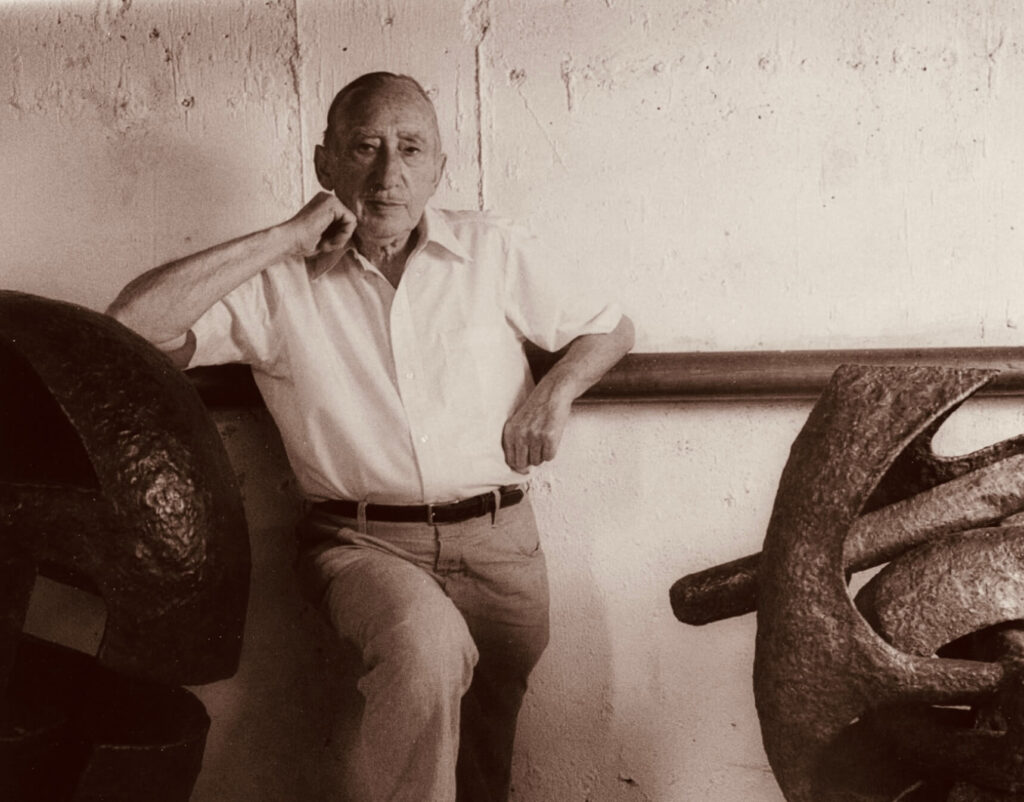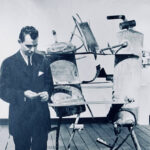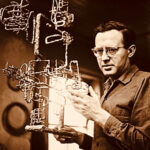Seymour Lipton
Seymour Lipton (1903-1986) was an American sculptor known for his innovative and expressive works in metal. His sculptures, characterized by their dynamic forms and emotional intensity, established him as a key figure in the post-World War II American art scene. Lipton’s journey from a practicing dentist to a celebrated artist is a testament to his unique vision and dedication to exploring the possibilities of modernist sculpture.

Early Life and Education
Seymour Lipton was born on November 6, 1903, in New York City. He grew up in a working-class Jewish family, which instilled in him a strong work ethic and a sense of determination. Lipton’s initial career path was far removed from the world of art. He pursued a degree in dentistry and graduated from Columbia University in 1927. For over a decade, Lipton practiced dentistry, a profession that provided him with financial stability but did not satisfy his creative ambitions.
Lipton’s interest in art began to surface during his years as a dentist. He took evening classes at the City College of New York and the Educational Alliance, where he studied drawing and painting. His exposure to art during these classes sparked a passion that would eventually lead him to abandon his dental practice and pursue a full-time career as an artist.
Transition to Sculpture
In the late 1930s, Lipton made the bold decision to leave dentistry and devote himself entirely to art. Initially, he focused on wood carving, creating abstract and semi-abstract forms that were influenced by African and Oceanic art. His early works were characterized by their organic shapes and a sense of rhythmic movement.
Lipton’s transition to metal sculpture in the 1940s marked a significant turning point in his artistic development. He began experimenting with various metals, including steel, nickel, and bronze, using techniques such as welding and brazing to create complex, layered compositions. This shift allowed him to explore new possibilities in form and structure, leading to the development of his signature style.
Breakthrough and Recognition
Lipton’s breakthrough came in the mid-1940s when he was invited to join the prestigious American Abstract Artists group. This association connected him with leading figures in the abstract art movement and provided him with a platform to showcase his work. His participation in exhibitions organized by the group helped him gain critical recognition and established him as a significant voice in American sculpture.
One of Lipton’s early notable works in metal is “Guardian” (1947), a sculpture that exemplifies his innovative approach to form and material. “Guardian” features a dynamic, abstract composition that evokes a sense of protection and strength. The use of welded steel and nickel creates a layered, textured surface that adds to the sculpture’s visual impact. This work, along with others from this period, demonstrated Lipton’s ability to convey emotional depth and complexity through abstract forms.
Mature Style and Themes
By the 1950s, Lipton had developed a mature style characterized by its expressive use of metal and its exploration of themes such as conflict, transformation, and the human condition. His sculptures from this period often featured sharp, angular forms and intricate, interlocking shapes that conveyed a sense of tension and movement.
Lipton’s work was deeply influenced by the events of World War II and the subsequent Cold War era. He sought to express the anxieties and uncertainties of the time through his sculptures, using abstract forms to convey complex psychological and emotional states. His work often reflected a sense of struggle and resilience, exploring the dualities of destruction and creation, conflict and harmony.
Important Artwork: “Winter Solstice” (1961)
One of Seymour Lipton’s most significant and celebrated works is “Winter Solstice” (1961). This sculpture is an excellent representation of his mature style and his ability to create powerful, evocative forms in metal.
“Winter Solstice” (1961)
“Winter Solstice” is a large-scale sculpture made from brazed nickel-silver and Monel metal. The work measures approximately 72 inches in height, making it an imposing and dramatic presence. The composition features a complex arrangement of sharp, angular forms that seem to burst outward from a central core. The interplay of light and shadow on the metal surfaces creates a sense of movement and dynamism, drawing viewers into the sculpture’s intricate details.
The title “Winter Solstice” suggests themes of transformation and renewal, which are reflected in the sculpture’s dynamic composition. The sharp, jagged forms evoke a sense of harshness and struggle, while the overall structure suggests a process of growth and emergence. This duality of destruction and creation is a recurring theme in Lipton’s work, reflecting his interest in the cycles of nature and the human condition.
One of the most striking aspects of “Winter Solstice” is its use of metal to convey a sense of organic vitality. Lipton’s ability to manipulate metal into complex, layered forms gives the sculpture a sense of life and energy, despite the inherent rigidity of the material. The work’s intricate details and dynamic composition invite viewers to engage with it from multiple angles, discovering new aspects and interpretations with each viewing.
“Winter Solstice” exemplifies Lipton’s mastery of metal sculpture and his ability to create works that are both visually compelling and intellectually engaging. The sculpture’s exploration of themes of transformation, struggle, and renewal makes it a powerful and enduring work of art.
Later Career and Legacy
Throughout the 1960s and 1970s, Seymour Lipton continued to refine his sculptural practice, creating works that were increasingly ambitious in scale and complexity. His later works often featured a more open and airy composition, with elements that seemed to float and interact in space. This period saw Lipton experimenting with new materials and techniques, further expanding the possibilities of metal sculpture.
Lipton’s work was widely exhibited during his lifetime, with solo exhibitions at major institutions such as the Whitney Museum of American Art, the Guggenheim Museum, and the Museum of Modern Art in New York. His sculptures were also included in numerous group exhibitions and international biennials, further cementing his reputation as a leading figure in modernist sculpture.
In addition to his contributions to the field of sculpture, Lipton was also an influential teacher and mentor. He taught at various institutions, including the New School for Social Research and the Pratt Institute, where he shared his knowledge and passion for art with a new generation of artists.
Lipton’s work is included in the collections of major museums around the world, including the Metropolitan Museum of Art, the Smithsonian American Art Museum, and the Art Institute of Chicago. His sculptures continue to be celebrated for their innovation, emotional depth, and technical mastery.
Personal Life and Philosophy
Seymour Lipton was known for his intellectual curiosity and his dedication to exploring the possibilities of art. He believed in the power of sculpture to convey complex emotions and ideas, and he saw his work as a way to engage with the broader social and political issues of his time. Lipton’s approach to sculpture was both intuitive and analytical, reflecting his background in both the sciences and the arts.
Lipton’s personal life was marked by a deep commitment to his family and his art. He was married to Alice Lipton, with whom he had two sons. Despite the demands of his artistic career, Lipton remained dedicated to his family, often drawing inspiration from his personal experiences and relationships.
Conclusion
Seymour Lipton’s artistic journey is a testament to his dedication to exploring the depths of modernist sculpture. Through his innovative use of metal and his ability to convey complex emotions and ideas through abstract forms, Lipton created a body of work that continues to inspire and challenge viewers. His notable work, “Winter Solstice,” exemplifies his mastery of form, material, and composition, highlighting his unique approach to sculpture.
In celebrating Seymour Lipton’s life and work, we recognize his significant contributions to the development of 20th-century sculpture and his enduring legacy as a pioneer of modernist art. His sculptures remain powerful and evocative, reminding us of the potential of art to engage with the human condition and the world around us.



